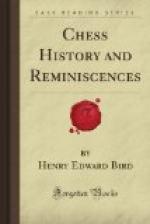The able article in Bailey’s 1885, on chess competitions and the progress of the game, and that in the Fortnightly Review of December 1886, entitled “The Chess Masters of the Day,” rank as the other most noteworthy productions of the last seven years’ period in chess.
I regret that it is not in my power to produce the more extended work, for to bring that now submitted within assigned compass and cost, I have had to omit much that would be needful to render such a work complete, and to give but a Bird’s eye view of chapters which would well merit undiminished space. Thus the complete scores and analyses of the matches, tournaments and great personal tests of skill and statistics of the game would be acceptable to a few, whilst the full accounts of individual players such as Philidor, Staunton, Anderssen, Morphy, Lowenthal, Steinitz, Zukertort, Blackburne and perhaps even Bird, (Bailey’s and Ruskin’s opinions) would be regarded and read with interest by many chess players.
Respecting the supposed first source of chess the traditional and conjectural theories which have grown up throughout so many ages, regarding the origin of chess, have not become abandoned even in our own days, and we generally hear of one or other of them at the conclusion of a great tournament. It has been no uncommon thing during the past few years to find Xerxes, Palamedes, and even Moses and certain Kings of Babylon credited with the invention of chess.
The conclusions arrived at by the most able and trustworthy authorities however, are, that chess originated in India, was utterly unknown to the Greeks and Romans, and was first introduced into Europe from Persia shortly after the sixth century of our era. In its earliest Asiatic form styled the Chaturanga, It was adapted for four persons, having four small armies of eight each. King, three pieces answering to our Rook, Bishop, and Knight, Elephant (Chariot or Ship,) and Horse, with four Pawns. The players decided what piece to move by the throw of an oblong die.
About 1,350 years ago the game under the name Chatrang, adapted for two persons with sixteen piece on each side, and the same square board of 64 squares, became regularly practiced, but when the dice became dispensed with is quite unknown.
It may not be possible to trace the game of chess with absolute certainty, back to its precise source amidst the dark periods of antiquity, but it is easy to shew that the claim of the Hindus as the inventors, is supported by better evidence both inferential and positive than that of any other people, and unless we are to assume the Sanskrit accounts of it to be unreliable or spurious, or the translations of Dr. Hyde, Sir William Jones and Professor Duncan Forbes to be disingenuous and untrustworthy concoctions (as Linde the German writer seems to insinuate) we are justified in dismissing from our minds all reasonable doubts as to the validity of the claims of the Hindu Chaturanga as the foundation of the Persian, Arabian, Medieval and Modern Chess, which it so essentially resembled in its main principles, in fact the ancient Hindu Chaturanga is the oldest game not only of chess but of anything ever shown to be at all like it, and we have the frank admissions of the Persians as well as the Chinese that they both received the game from India.




